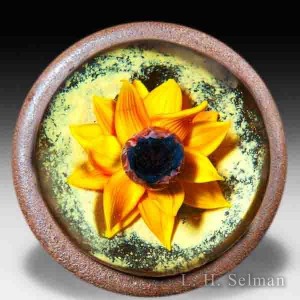How do they make Glass Paperweights Ebook published by The Glass Gallery
 The Glass Gallery / L.H. Selman LTD just put the whole of Larry H. Selman’s seminal book, “The Art of The Paperweight” online. All pages and pictures from this book are now totally free and available through the new ebooks section of our website. In fact, we recently began to digitize our entire library of paperweight related books. For the first time ever, this encyclopedic collection of valuable writings will be made available to the entire paperweight community and the general public. This includes books by Rick Ayotte, Art Elder, Larry Selman, and many others. Thousands of pages in all. We invite you to enjoy and share these new ebooks; and we welcome your careful review of “The Art of The Paperweight” and other books, as we release them over the coming months.
The Glass Gallery / L.H. Selman LTD just put the whole of Larry H. Selman’s seminal book, “The Art of The Paperweight” online. All pages and pictures from this book are now totally free and available through the new ebooks section of our website. In fact, we recently began to digitize our entire library of paperweight related books. For the first time ever, this encyclopedic collection of valuable writings will be made available to the entire paperweight community and the general public. This includes books by Rick Ayotte, Art Elder, Larry Selman, and many others. Thousands of pages in all. We invite you to enjoy and share these new ebooks; and we welcome your careful review of “The Art of The Paperweight” and other books, as we release them over the coming months.
For you especially, the devout paperweight aficionado, please know that although we were careful in our scanning and book conversions, the process of pushing old printed pages for best online reading is not perfect. We know there may be mistakes, feel free to let us know what you find so we can make this an even better resource. We will review all your posted comments, including anything you care to let us know about errors and corrections.
“In October 1951, a magnificent millefiori paperweight was found in the cornerstone of the old parish church at Baccarat, which had been severely damaged during World War II. The weight, which included an 1853 date cane, contained 233 millefiori canes. The piece was made by Baccarat’s master craftsman at that time, Martin Kayser. The discovery of the “Church Weight,” as it has come to be called, helped rekindle interest in paperweight making at Baccarat.
The first contemporary weight made by the factory was not, interestingly enough, a millefiori design. Because Baccarat had no records of the millefiori technique, it took several years of research and experimentation before its craftsmen finally succeeded in producing some millefiori pieces in 1957. By that time the company had already rediscovered, mastered, and begun production of another style of paperweight—the sulphide.





